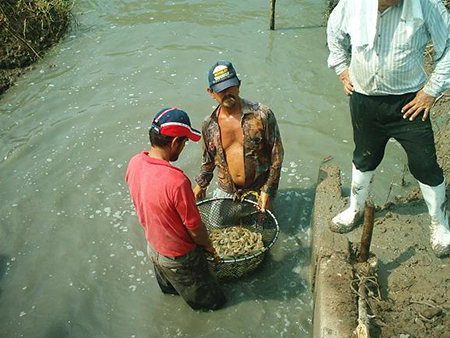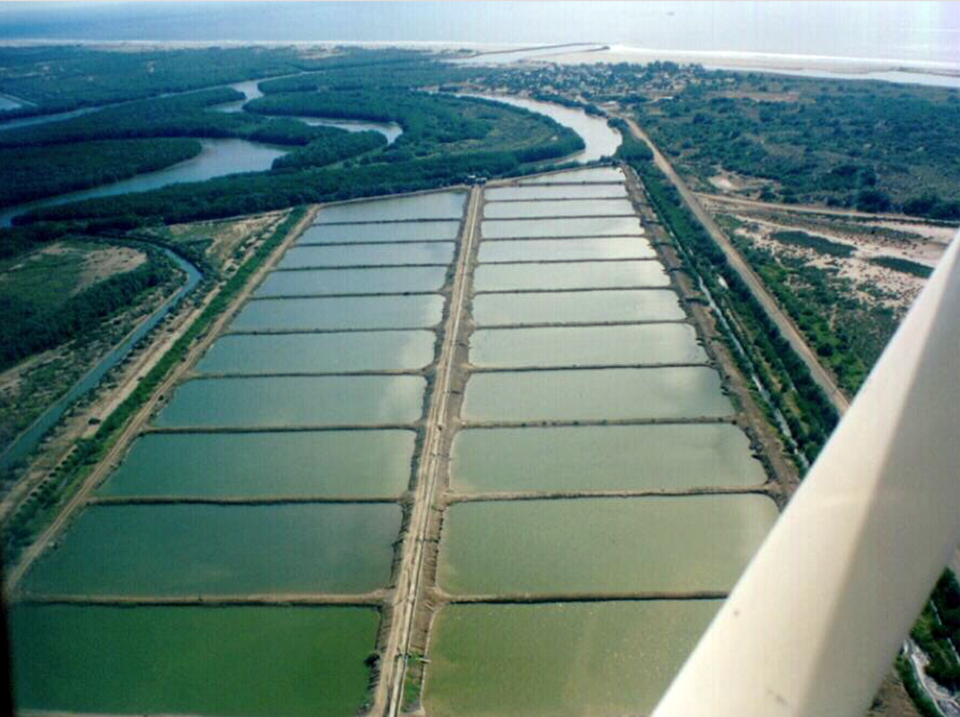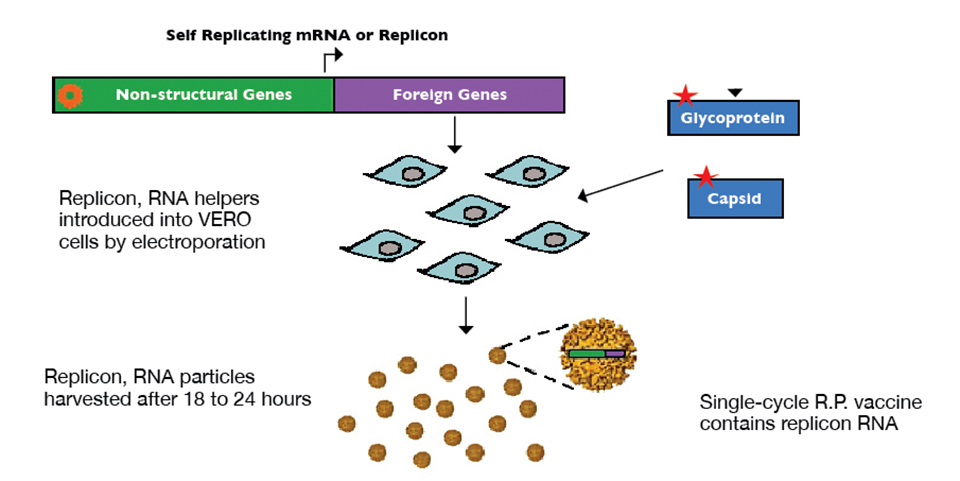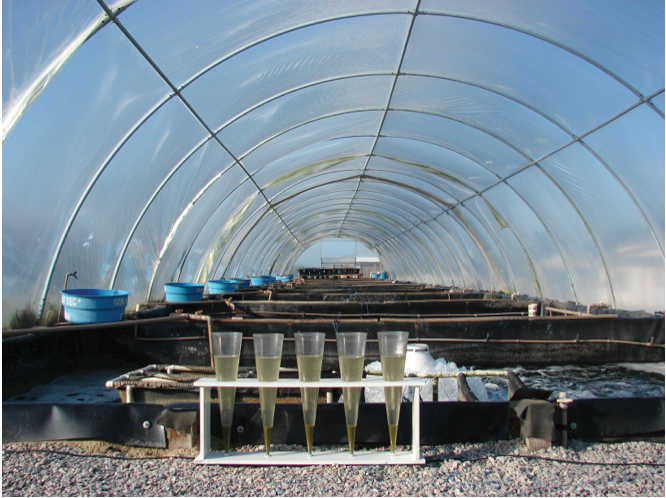Growing in cooler months is feasible, with or without pond water exchange

Since 1985, shrimp farming has developed significantly in northwestern Mexico along the coastal lagoons of the states of Nayarit, Sonora, and Sinaloa. The latter experienced the greatest growth 1985 to 1999, when the industry went from one 200-ha farm to 226 farms with a total surface area over 35,000 ha.
However, due to annual temperature variations, the farming of Pacific white shrimp (Litopenaeus vannamei) is limited to those months when pond water temperatures are above 24 degrees-C, normally from mid-March to mid-November. During these months, L. vannamei typically have an average growth rate of 0.98 grams per week. During the remainder of the year, pond temperatures fall below 20 degrees-C, which limits shrimp growth.
Alternatives to expand production
The shrimp-farming industry is facing several problems, including declining prices due to an oversupply of shrimp during July-August and November-December. Shrimp farmers are looking for alternate production strategies to reduce the risk of viral infection and get higher market prices for their product. The farming of shrimp tolerant to low temperatures, such as Penaeus chinensis, has been considered, but the introduction of such exotic species is not recommended, due to the risk of the introduction of new pathogens.
One strategy adopted by some farmers is the stocking of shrimp ponds in October in order to harvest in March-April, when shrimp prices are higher. The results have apparently been satisfactory, but not publicized by the private sector, where much information is stored without being analyzed.
In addition, most shrimp farms in Mexico exchange pond water at rates of 10 to 15 percent daily, which corresponds to about 10 percent of the operating costs. However, recent studies have shown that water-exchange rates can be reduced without adversely affecting production, and high production can be obtained even with no water exchange.

Grow-out study
The authors carried out a study to experimentally produce L. vannamei at a commercial farm in northern Sinaloa, Mexico, for 21 weeks during the cold months of October 2001 and March 2002. The study was done with and without pond water exchange to determine if shrimp growth rate would be adequate to sustain commercial farming.
Two treatments were used: grow-out with 10 to 15 percent daily water exchange and grow-out without water exchange. The completely random experimental design used 3 replicates per treatment. Hatchery-raised L. vannamei postlarvae (PL) from a commercial laboratory were stocked at 10 PL per cubic meter in six earthen, 5,000-square-meter ponds. Feeding rates were adjusted weekly based on the average weight of shrimp in each pond.
Pond water temperature, salinity, pH, and dissolved oxygen were measured daily throughout the experiment. At the end, the shrimp were drain harvested, and a sample of 200 animals from each pond collected to determine final average weight, survival rate, and production. A student’s t analysis was carried out to determine if significant differences existed between the variables of the treatments.
Results
Water temperatures in the ponds fluctuated 13 to 20 degrees-C December-March. During this period, the average growth for shrimp was 0.56 grams per week, considered acceptable for commercial farming purposes. The average survival rate was low for both treatments, however, ranging from 23.2 degrees for ponds with water exchange to 26.1 percent in ponds without water exchange. The low survival related at least in part to a White Spot Syndrome Virus outbreak in all ponds detected on day 35 and confirmed by polymerase chain reaction testing.
Shrimp production ranged from 252.60 kilograms per hectare in ponds without water exchange to 274.60 kilograms per hectare in ponds with water exchange. These results are low when compared to reported data for the species. L. vannamei generally range 800 to 10,000 kilograms per hectare per cycle, but at much higher water temperatures of 24 to 31 degrees. Production levels over 3,500 kilograms per hectare typically require mechanical aeration.
Based on the student’s t analysis of the data, there were no significant differences (P < 0.05) between the treatments evaluated. This indicated that at the low water temperatures prevailing during this experiment, it is possible to reduce or totally eliminate water exchange without negative effects on production, concurrent with a significant reduction in operating costs.
Conclusion
Despite the low production rates obtained, which could likely be improved by better management practices and more experience working under these conditions, the study results provided valuable information about the growth rate and production potential of L. vannamei during the autumn and winter seasons in northwestern Mexico. Shrimp ponds are normally fallow during this period, but it is feasible to grow shrimp in cooler months, with or without pond water exchange.
Note: Cited references are available from the authors.
(Editor’s Note: This article was originally published in the December 2003 print edition of the Global Aquaculture Advocate.)
Now that you've reached the end of the article ...
… please consider supporting GSA’s mission to advance responsible seafood practices through education, advocacy and third-party assurances. The Advocate aims to document the evolution of responsible seafood practices and share the expansive knowledge of our vast network of contributors.
By becoming a Global Seafood Alliance member, you’re ensuring that all of the pre-competitive work we do through member benefits, resources and events can continue. Individual membership costs just $50 a year.
Not a GSA member? Join us.
Authors
-
Hector M. Esparza-Leal
Departamento de Acuicultura
CIIDIR – Instituto Politécnico Nacional
Unidad Sinaloa
km 1.0 Carretera a las Glorias
Guasave, Sinaloa, Mexico -
Wenceslao Valenzuela-Quiñónez
Departamento de Acuicultura
CIIDIR – Instituto Politécnico Nacional
Unidad Sinaloa
km 1.0 Carretera a las Glorias
Guasave, Sinaloa, Mexico -
Jesus T. Ponce-Palafox
UAEM-CIB
Cuernavaca, Morelos, Mexico -
Hector Cabanillas-Beltrán
ITT
Tepic, Nayarit, Mexico
Tagged With
Related Posts

Health & Welfare
Alphavirus replicon particles potential method for WSSV vaccination of white shrimp
A study demonstrated that VP19 and VP28 white spot syndrome virus envelope proteins expressed by replicon particles provided protection against mortality due to WSSV in shrimp.

Health & Welfare
Ammonia addition enhances microbial flocs in nursery phase for Pacific white shrimp
In a study, “pre-fertilization” in the nursery phase of a biofloc system for shrimp was tested. The objective was to accelerate the biofloc formation to minimize ammonia concentrations, avoiding high peaks during culture.

Aquafeeds
A look at protease enzymes in crustacean nutrition
Food digestion involves digestive enzymes to break down polymeric macromolecules and facilitate nutrient absorption. Enzyme supplementation in aquafeeds is a major alternative to improve feed quality and nutrient digestibility, gut health, compensate digestive enzymes when needed, and may also improve immune responses.

Responsibility
A look at various intensive shrimp farming systems in Asia
The impact of diseases led some Asian shrimp farming countries to develop biofloc and recirculation aquaculture system (RAS) production technologies. Treating incoming water for culture operations and wastewater treatment are biosecurity measures for disease prevention and control.


